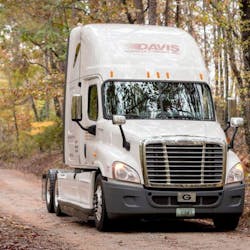As mobile devices and apps — and everyday use and growing reliance on them — have spread at a pace rabbits and bacteria might envy, fleets have been acting to curb distracted driving in their trucks. The U.S. Dept. of Transportation’s (DOT) bans on texting and hand-held cell phone use while operating commercial motor vehicles since 2010 and 2012, respectively, are advancing those efforts.
Meanwhile, faced with big hikes in insurance premiums and both fraudulent and legitimate lawsuits following collisions, motor carriers also want to eliminate any accidents they can. DOT data shows that in 2015, fatalities on America’s roadways grew by 8%, the largest year-over-year increase in half a century — and everywhere you look, all fingers seem to point at distracted driving.
When it comes to distracted driving, some fleets are now going farther than what’s required by law, like prohibiting even hands-free cell phone use behind the wheel where such calls are perfectly legal. Is all the fuss really warranted, and is banning things like cell phone use of any kind while driving the best way to approach this problem?
Technology: Culprit and solution
On one hand, cell phones and other mobile, Internet-connected devices are what anti-distracted driving laws target most, and they’ve come to define distracted driving in the Information Age. At the same time, technology is also helping solve this problem: passenger cars and commercial vehicles alike are touting advanced tech like lane departure and condition-based risky speed warnings or automatic braking to avoid collisions. Third-party developers are offering driver-monitoring systems designed to spot and guard against distracted driving.
Even as DOT is pressing voluntary guidelines for in-vehicle and mobile devices to limit technology’s potential for distraction, the agency has just proposed a new rule requiring and laying the groundwork for vehicle-to-vehicle, or V2V, safety message communications. DOT claims V2V technology — that is, vehicles wirelessly communicating things like their speed, direction and coordinates to each other — could drive advanced safety functions like autonomous braking and could help avoid “hundreds of thousands” of collisions every year.
"Years ago, when I saw people driving how I'm seeing them drive today, my first thought was, 'They're drunk' . . . Today, you pretty much think, 'They're playing with their phone.'"
—Herschel Evans, seasoned Holland driver
Thus technology has become like the humorous old illustrations of conscience: picture devil and angel figures on either shoulder of the driver. To be sure, no one advocates driving distracted. But the reality is that, depending on how you define it, just about any action by a driver that isn't eyes forward, hands at 10 o’clock and 2 o’clock, and attention fully on the task of driving itself could be considered a distraction. A “distraction threshold” commonly cited is 2 seconds or more looking away from the road.
Many things people have been doing since the advent of the automobile arguably could fall into that category. And if the driver looking anywhere other than the road ahead and adjoining peripheries in a moving vehicle can be a problem, why are OEMs putting increasingly advanced media centers, touchscreen displays, camera feeds, and more in both commercial vehicles and passenger cars?
Beyond what’s required
Amid the distracted driving debate, keep in mind that electronic logging devices (ELDs) will be required in heavy trucks for drivers who now have to keep paper logs starting in December, meaning yet one more device, although ELDs must also have a “driving mode” that engages while the truck is moving and reduces potential driver distraction. For its part, New York City has taken what could be seen as a similar lockout tactic to mobile phone use in its approaching 30,000 fleet vehicles, banning even hands-free calls last spring.
“We think this is the right thing to be doing,” says Keith Kerman, NYC’s chief fleet officer and deputy commissioner of the Dept. of Citywide Administrative Services (DCAS), which oversees the city’s numerous fleets. Since banning hands-free phone use while operating city vehicles — exceptions include emergency radios such as those used by police or making emergency calls — and taking other safety steps like adding side guards to trucks to prevent pedestrians and cyclists from getting pulled under them, Kerman notes that injuries and fatalities have been dropping.
“Those have been going down even as we’re increasing the number of vehicles and total miles driven,” he tells Fleet Owner. “While we’re making progress in reducing fatalities and injuries on New York City’s roads, unfortunately, the opposite is happening across the country.”
DCAS and the city’s fleets are taking the position — and promoting it with new ad campaigns — that “safe driving is focused driving.” But Kerman says he recognizes the duality of technology inasmuch as it can be a big source of distraction yet also has the potential to reduce or possibly eliminate it.
“We know that human beings and the human mind can handle only so much distraction, and we want our drivers focused on the road,” he stresses. “If in a beautiful future someday cars are taking care of the driving function — or most of it — and are keeping us safer, we’ll be thrilled. We’ll try to be an early adopter.
“But today, [cell phones and other mobile devices] are distractions, and we worry about the risk,” Kerman continues. “We’re more concerned that our drivers stay safe and set the phone aside.”
Indeed, although hands-free calls while driving are legal in New York State and most others, Kerman says he believes lawmakers may have gotten that wrong. “Hands-free phone use is really not safer, and there was an error made in suggesting that it is,” he argues. “The issue is distraction, not just kind of having your right or left arm physically raised. Using a phone hands-free is just as distracting as using a handset.”
Not all distractions equal
How far does the “everything that isn’t focused driving is a distraction” conversation need to go? Herschel Evans, who’s been a truck driver for some 30 years, driving for truckload carrier Holland for nearly 23 of those, points out a subtle but significant distinction: the real distraction while driving isn’t necessarily where your eyes go, but rather your mind.
“There are things you normally have to do when you’re driving,” he notes. “You might have to shift gears, check mirrors, or check gauges — that’s always been the case — and you can make any of those a distraction if you let them take too much of your attention.”
And that’s why mobile devices are such a distraction in the driving environment, Evans contends: they take the driver’s attention very notably off of the road ahead and piloting the vehicle. “There’s practically no way to read a text or type an email without having your direct focus totally taken away from the road and put on a device,” he says. “You change that direct focus and you have to concentrate pretty hard on something to be able to read a paragraph and understand what it means; it could even be a short sentence.”
Perhaps even more so than police officers, Evans notes, truck drivers can spot distracted drivers because of their higher vantage point. “We see exactly what’s going on — there’s no way to hide it from us,” he points out. “It’s obvious to us [truck drivers] during the day, but it’s really obvious at night because there’s a glow from a screen as they’re playing with their phone or tablet and driving down the road.”
Many studies, including information from DOT, suggest that drivers distracted by mobile devices have the same or even worse impairment than drunk drivers. Evans agrees. “Years ago, when I saw people driving how I’m seeing them drive today, my first thought was, ‘They’re drunk,’” he says. “They’d be weaving or getting across the line; they’d be coming into your lane.
“Today, you pretty much think, ‘They’re playing with their phone,’” Evans adds. “It’s the exact same actions. They’re not staying in their lane, they’re going off the road, and they’re doing things that are going to get them into trouble and get them in a collision.”
‘Not just lucky’
Carnesville, GA-based truckload carrier Davis Transfer Co. has always tried to limit accidents and screened drivers in efforts to have its trucks be as safe on the roadways as possible, according to Todd Davis, the company’s president. But after being involved in “a fair amount of litigation” related to collisions over the last seven or eight years, Davis Transfer began looking into video systems to monitor drivers and record what’s happening around its trucks.
The very day the company went to check out a video- and data-based truck safety product from SmartDrive Systems, one of Davis’s trucks got in a collision with a cyclist. “That persuaded me that as soon as something like that happened, we needed to know immediately or very quickly afterward what we were dealing with,” Todd Davis says. “We committed to a pilot program [with the SmartDrive product]. There was really no hesitation once we saw what the technology could do for us.
“It was going to put us in a position where we were going to be able to see not only accidents, but behaviors that could lead to an accident,” he continues. “Certainly, all of us today are challenged with the technology that the driver has in the cab: texting, talking on the phone, etc. A lot of distractions are going on.”
And regarding those problem behaviors and distractions, that’s where the company discovered that some of its drivers weren’t quite as safe as it had thought — even some of the best ones.
“We really worked with some of our drivers that we considered to be cream-of-the-crop, top-notch people,” explains Brittany Britt, director of safety and personnel at Davis Transfer. “And very early, it became evident that some of the drivers we had, yes, they’re great operational drivers, but in a lot of situations, they were just straight-up lucky.”
Once the SmartDrive system was in place, one driver in particular who was considered one of the company’s best ended up having the system detect a number of adverse events, Britt says. “He was running the truck off the road and would get things that would actually trigger the event recorder, and what we found was that he had a really bad habit of looking at his phone while he was driving.”
Davis Transfer used the SmartDrive system to design a coaching program specifically for this driver, she adds, and the driver adjusted his behavior. “We pulled him aside to say, ‘Look, you’re a great driver and we appreciate everything you do for the company, but we need to work on this as a team and get you the safest you can be on the road,’” Britt recalls.
"After he went through the training, he kind of saw, 'Yeah, I have a problem,'" she notes. "We've had the system for over a year now, and he's one of our safest drivers. Now he's not just lucky, he's safe."
Take the wheel away?
Some believe that trying to legislate and police against potential distractions behind the wheel ultimately is ineffective. A 2013 study published in the American Economic Journal, for instance, examined vehicular fatality data from across the United States and found that “any reduction in accidents following texting bans [while driving] is short-lived . . . with accidents returning to near-former levels within a few months.”
Given the growing number of connected mobile devices individuals have — from cell phones to tablets, laptops, fitness devices, and who-knows-what to come — will it take fully autonomous vehicles to reach distraction-free roadways? That is, must humans be removed from the driving equation altogether?
Kerman and Evans don’t think so. “I think there has in fact been progress in getting people to not use hand-held phones and not text while driving,” Kerman contends. “The idea that you can’t effectively achieve public benefit through regulation, I think, is just not consistent with the facts.”
And on that note, Evans — who helps get the message out about distracted driving as a professional driver with the American Trucking Assns.’ “Share the Road” public safety outreach program — notes that laws have been more effective in some places than others. Anecdotally, he points out that states with stiffer penalties for distracted driving like California seem to have made more progress than others like his home state of Georgia.
“I think that sooner or later, everyone will get the message,” he says, and distracted driving “will kind of go the way that drunk driving did” where people became proud to be a designated driver. Evans surmises that people are still in “an infatuation stage” with mobile devices.
“I hope that somewhere along the line, we get to that point where distracted driving has the same stigma that we’ve rightfully given to drunk driving,” he says. “We know this is not safe, we know it’s ugly, and we know it’s something that shouldn’t be done. At what point do we just say enough is enough — we’ve got to stop this?”
About the Author
Aaron Marsh
Aaron Marsh is a former senior editor of FleetOwner, who wrote for the publication from 2015 to 2019.



